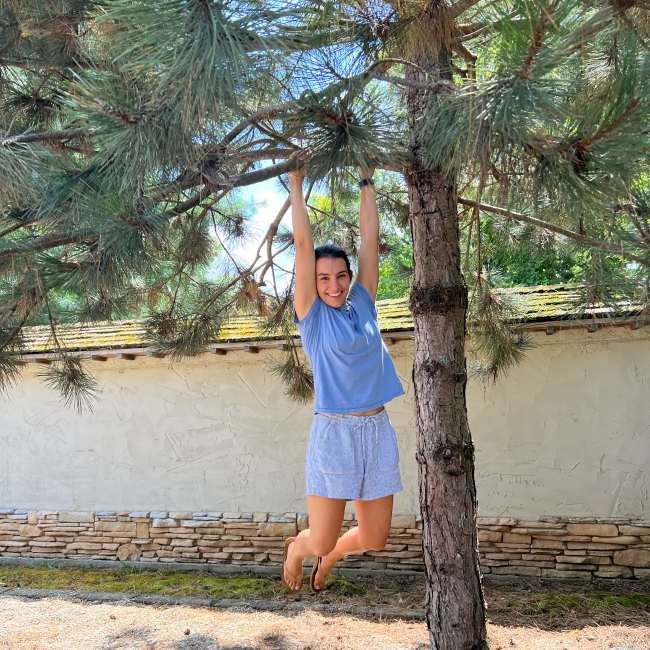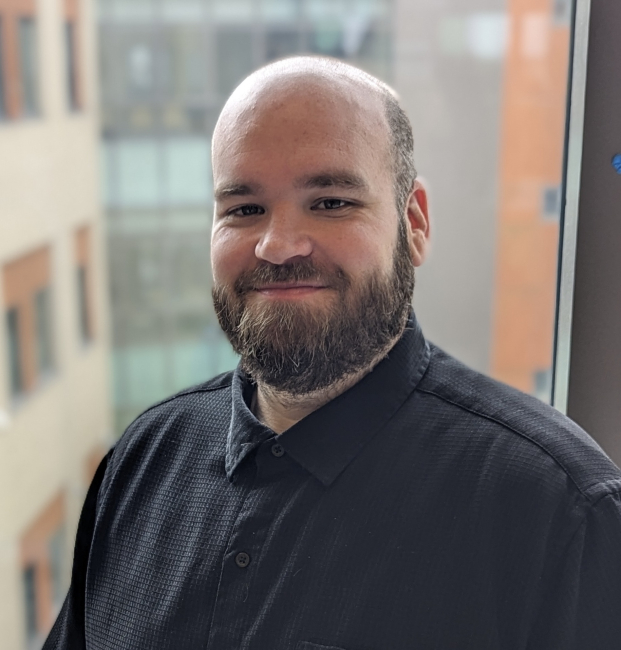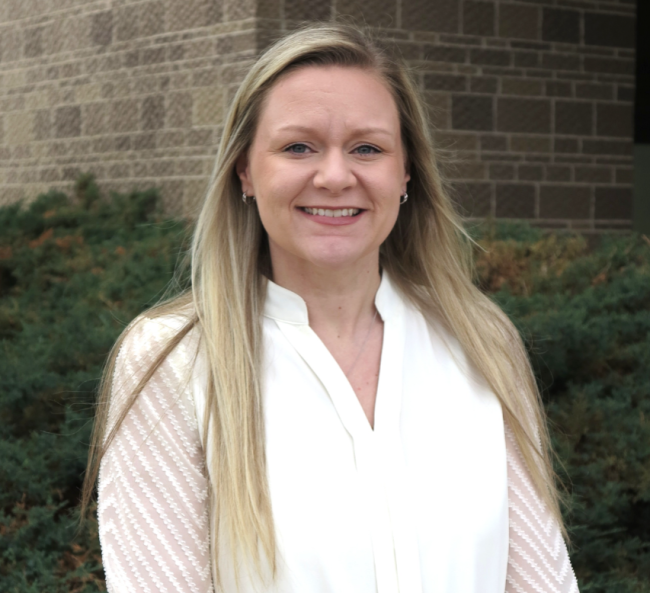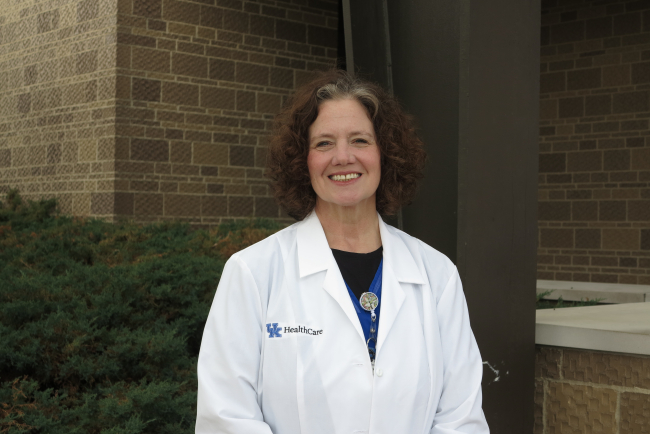Take, for instance, a wide-angle shot of a person standing before a grove of towering trees. Without thoughtful framing, the individual can easily blend into the vastness of the natural surroundings, becoming nearly unnoticeable. However, by strategically using elements like branches or flowers to form a natural vignette around the person's face, they become the clear focal point of the image—immediately capturing the viewer’s attention.
Environmental
Test anxiety is a common issue among students, potentially leading to adverse academic consequences. Students with psychological distress are more susceptible to test anxiety. Adverse childhood experiences (ACEs) have been linked to psychological distress. However, there is a lack of studies on the associations between ACEs, psychological distress, and test anxiety in college students.
Document Category
Dimensions of Wellbeing
Published Date
|
|

|
Viewing the World Through a LensViewing the World Through a Lens
Categories
The way we perceive and interpret the world around us has a profound impact on our emotions and behavior. This concept is central to Cognitive Behavioral Therapy (CBT), which highlights the role of thoughts in shaping our actions. Interestingly, a similar principle applies to photography through a technique known as framing, where the way a subject is composed within a photo can dramatically alter its meaning. Framing in photography involves using natural or man-made elements within a scene to create a "frame" around your main subject. This technique draws the viewer's focus to the subject, enhancing its visual appeal and emotional impact. For example, envision capturing a photo through an intricately carved doorway that acts as a decorative frame, naturally drawing the viewer’s eye toward the scene unfolding in the distance. Alternatively, you might capture the essence of a person by utilizing overhanging branches, vibrant flowers, or a rustic bridge to surround their figure. These elements not only highlight the subject but also add depth and context to the image. 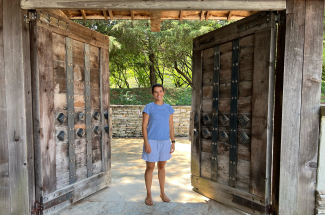
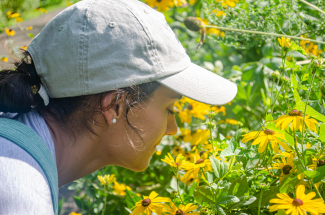
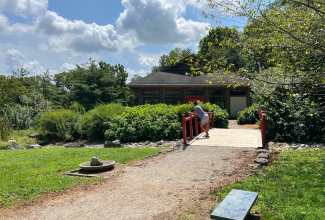
Poorly FramedThe subject is lost in the background. 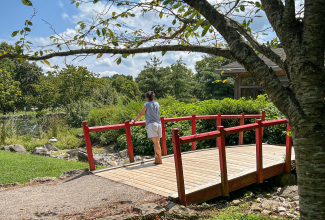
Well FramedThe subject becomes the focal point. Mastering outdoor photography requires careful consideration of various factors, including location, lighting, and the art of framing. Just like in photography, life often presents situations that are beyond our control. Yet, we hold the power to choose how we interpret and respond to them. The way we frame our experiences—through our thoughts and perspectives—not only influences our emotional well-being but also shapes how we move through the world and understand ourselves. Seek out a narrative that is empowering—one that aligns with your experiences and strengthens your sense of self. Remember, you have the ability to shape your own reality by choosing the story you tell yourself with intention and purpose. So, ask yourself: What narrative will you choose to embrace? ReferencesAdobe. (n.d.). What is framing in photography. Www.adobe.com. https://www.adobe.com/creativecloud/photography/hub/guides/what-is-framing-in-photography.html American Psychological Association. (2017). What Is Cognitive Behavioral Therapy? American Psychological Association. https://www.apa.org/ptsd-guideline/patients-and-families/cognitive-behavioral Firefly Photography. (2023, September 28). Photo Studio Singapore. Photography Services Singapore. https://fireflyphotographysg.com/photo-studio-blog/3-key-differences-between-studio-outdoor-photography/ Dimensions of Wellbeing
|
Factors Associated With Telehealth Usability Among Medicaid Beneficiaries With Mental Illness: A Cross-Sectional Analysis of Consumers and ProvidersBackground: Telehealth offers a flexible and effective alternative to in-person behavioral health services, with users generally reporting high satisfaction. However, several barriers can limit equitable access among Medicaid beneficiaries.
Document Category
Dimensions of Wellbeing
Published Date
|
|
Social and environmental factors during the smoking cessation process: The experiences of adults with serious mental illnessesPeople living with schizophrenia and other serious mental illnesses (SMI) face a disproportionate burden of tobacco-related prevalence and, consequently, tobacco-induced morbidity, in comparison to those without SMI. Document Category
Dimensions of Wellbeing
Published Date
|
|
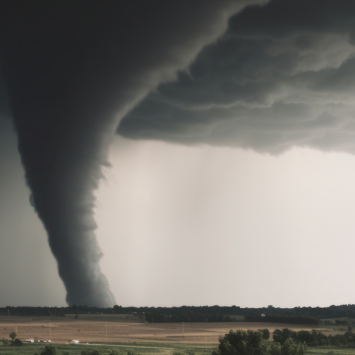
|
Finding Calm Among the TornadoesFinding Calm Among the Tornadoes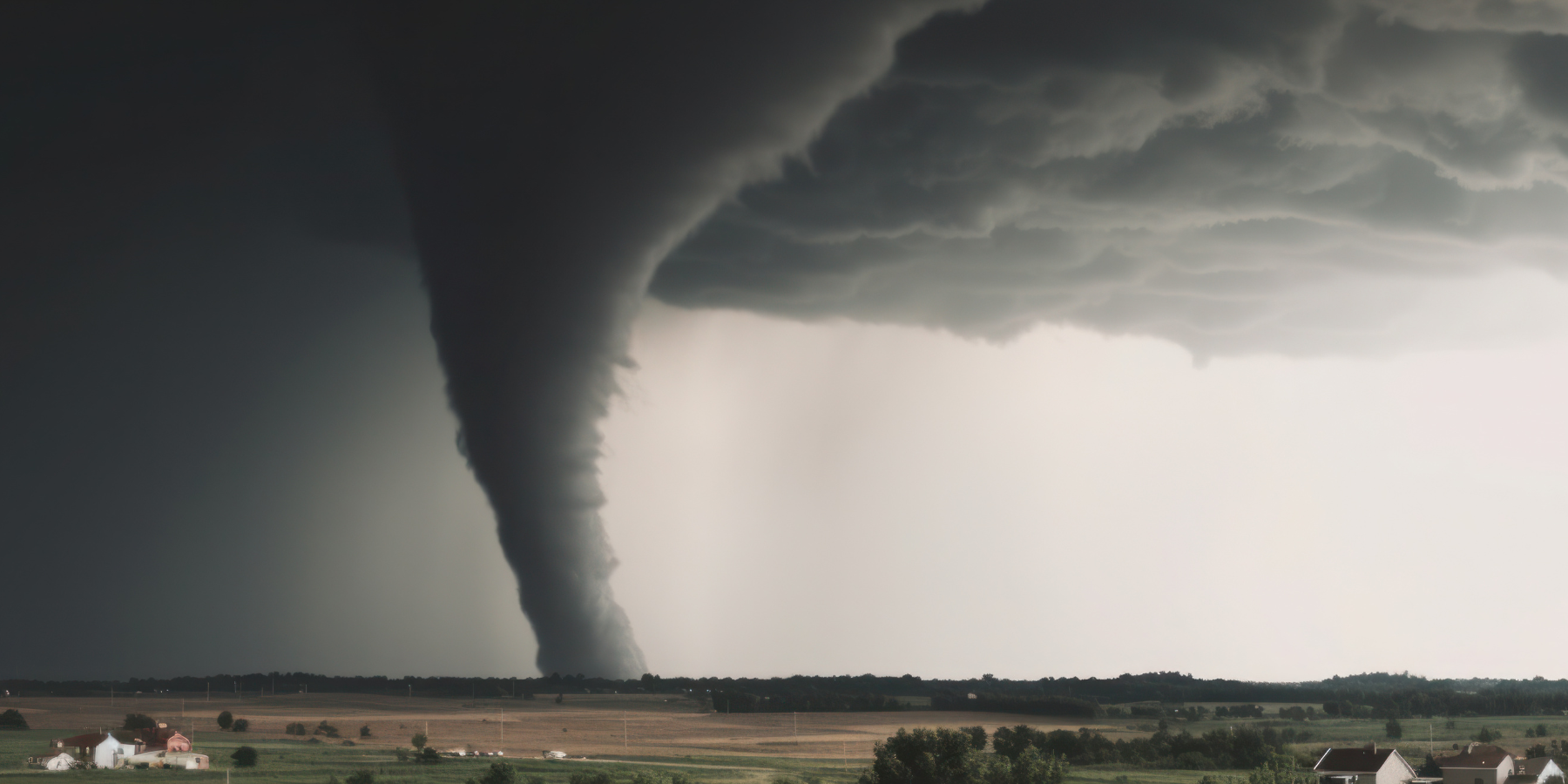
Categories
As a student completing my clinical experiences, I often meet amazing patients who find themselves in difficult circumstances. It is as if they have come face to face with a tornado. This happens often enough that I decided to write a blog about how one might begin to see the tornado for what it is and realize that they get to choose how they will face their difficult circumstances. Tornadoes arise quickly and often when we least expect them! It is the same thing with difficult circumstances. Whether it’s a health issue or other unexpected circumstances, that tornado can leave us feeling overwhelmed or helpless. During these times, it might seem impossible to find a way to move forward. One thing that seems simple but can help, is choosing to sit with the present circumstance mindfully without judgement. “Okay. That is one large tornado! But I have a supportive family and health providers who are trained to walk alongside me through my challenges.” Reality, the tornado, is acknowledged for what it is while allowing space for self-compassion and acceptance. There is help. There is hope. If you or someone you love is going through a difficult circumstance, contact the Crisis Lifeline at 988 or dial or text #988. ReferencesBiehler, K. M., & Naragon-Gainey, K. (2022). Clarifying the Relationship Between Self-Compassion and Mindfulness: An Ecological Momentary Assessment Study. Mindfulness, 13(4), 843–854. https://doi.org/10.1007/s12671-022-01865-z Ford BQ, Lam P, John OP, Mauss IB. The psychological health benefits of accepting negative emotions and thoughts: Laboratory, diary, and longitudinal evidence. J Pers Soc Psychol. 2018 Dec;115(6):1075-1092. doi: 10.1037/pspp0000157. Epub 2017 Jul 13. PMID: 28703602; PMCID: PMC5767148. Dimensions of Wellbeing
|
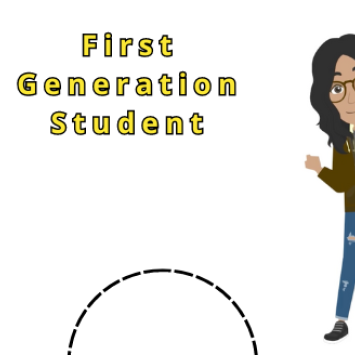
|
First Generation StudentFirst Generation Student
Categories
The life of a first-generation student is a triumphant one! Hold on, before you continue. I must introduce myself. My name is Kayla Vargas. In this blog, I’ll tell you my story as a first-generation student. The life of a first-generation student is a triumphant one but sometimes it can feel isolating. “How is it?” A question I’ve been asked a hundred times for various reasons. The frequency of this question increased when I started college, especially from my family members who never went to college. Typically, this question refers to my experience in the nursing program. My response is usually something like, “Oh, you know. It’s just regular college, just significantly harder.” It’s kind of ironic to say “you know” to the people who “don’t know” what it’s like. However, all I can do is shrug my shoulders and respond vaguely. Truth is, I don’t know how to explain my experience to them. The life of a first-generation student is a triumphant one but sometimes it can be filled with failure. In my second semester of freshman year, I finally decided on my major, Nursing. As many of you may know, the nursing program has a lot of prerequisites that have to be fulfilled before applying. So, to fulfill those prerequisites, I decided to do them ALL in one semester. You guessed correctly. It did not go well! I did not meet the standard set by the UK College of Nursing and, therefore, was not accepted the first time I applied. But guess what? I tried again the following year and was accepted. I felt unstoppable! Until… I had to meet some medical prerequisites and tested positive for tuberculosis. Though testing positive for tuberculosis wasn’t necessarily under my control, to me, it was equivalent to a failure. Now, I'm in nursing school. I fail multiple times a day. (Sigh… I’ll leave how up to your imagination.) Yes, I’m being hyperbolic. But, what’s nursing school without failure? While I’m failing, I’m succeeding.
The life of a first-generation student is a triumphant one but sometimes I’m not sure if I’m cut out for this. AKA self-doubt. After being rejected the first time I applied to nursing school, I wondered if I was smart enough, hard-working enough, compassionate enough, resilient enough to actually “do” college. When applying my second time, I believed that I would get in… but a nagging thought wouldn’t leave me. After failing so many times, did I deserve to be given a seat? Even if I did get into nursing school, would I be cut out to graduate? And even if I did deserve it, or if I did graduate, I still had the lingering doubt that I could never be, what I believe to be, a “good” nurse.
The life of a first-generation student is a triumphant one, but sometimes it’s burdensome. I grew up in California. It’s competitive there and for some reason, I felt the need to compete. To have a competitive college application, I took Advanced Placement (AP) classes in high school. My AP Chemistry teacher said something to my class that I can’t seem to forget. She said, “Be proud of yourselves. You are the cream of the crop.” At that moment, I was proud. I had a great GPA, was involved in a lot of extracurriculars, had volunteer hours, and was doing all the things I was supposed to do for success. Well, that pride did not last long. AP Chemistry was hard. I understood nothing. I barely passed but I survived to tell the story. I tell you this because first-generation students have this particular burden to be the “cream of the crop”. My grandparents came from Mexico and my parents were unable to go to college due to their circumstances.
Now, my generation is supposed to go to college. I live in a “creamy” country with “creamy” circumstances. I also have this “creamy” opportunity to go to university. I am very blessed but there is this undeniable, hidden pressure. My older family looks down on me as if my success is a reflection of what they’ve achieved. My younger family members look up to me as if my success is a symbol of what they could achieve. But what if I fail? What if I am not the “cream of the crop?” What if I never was?
The life of a first-generation student is a triumphant one, indeed, it truly is triumphant. Sure, being a first-generation college student comes with many hardships; but regardless of educational status, life comes with hardships. It’s like a rite of passage to triumph. Without hardships, there is no triumph. How can there be a triumph without the risk of defeat? How can someone truly experience triumph without first being defeated?
The past few passages may have felt a little bit…despondent and, for some time, they felt that way too. Now, as a third-year student, these pressure points have turned from a hindrance to an opportunity for edification.
Is my life filled with various failures? Of course. And sometimes failure can be embarrassing and discouraging. But, resilience is developed through endurance. Self-doubt and pride fluctuate. Neither is beneficial. But every day, in one way or another, I’m either encouraged or humbled healthily. Outwardly, it seems that success follows failure; but in a way, they are simultaneous. So as a first-generation student, I can safely say that college is a great place to fail many times, succeed many times, learn many things and focus on today. Dimensions of Wellbeing
|
Assessing Tobacco Treatment Engagement in Assertive Community Treatment ProgramsDespite high tobacco use prevalence among those with serious mental illnesses, few Assertive Community Treatment (ACT) programs provide tobacco treatment. Understanding the factors associated with the intentions to engage in tobacco treatment from both provider and consumer perspectives is important. Document Category
Dimensions of Wellbeing
Published Date
|
|

|
Graduate Spotlight: Kevin Bryant, DNPGraduate Spotlight: Kevin Bryant, DNP
Congratulations to Kevin Bryant, DNP, BSN, on his graduation from the University of Kentucky (UK) College of Nursing (CON) with his Doctor of Nursing Practice (DNP). Dr. Bryant’s project, “The Impact of an Educational Training to Front-line Nurses and Providers to Reduce Seclusion and Restraint: Assessing Knowledge, Practices, and Attitudes” explores effect of web-based educational intervention on front-line nurses knowledge, practices, and attitudes concerning use of seclusion and restraint of patients within psychiatric in-patient facilities. Dr. Bryant is Director of Inpatient Services at Eastern State Hospital (ESH). Dr. Bryant traces his passion for nursing back to his experience working with residents at a nursing home in his senior year of high school. This early clinical exposure ignited his confidence to pursue UK’s College of Nursing program where he completed his BSN in 2011. Bryant began his career with ESH in 2012 as a clinical nurse and served as interim nurse manager beginning in 2014.
Bryant had the desire to continue his education and enrolled into UK’s DNP program in 2020. Flourishing under the mentorship of Dr. Woods, Bryant notes, “Dr. Woods was always very supportive and proud of us and always provided opportunities.”
Dr. Marc Woods, Chief Nursing Officer for UK Healthcare, shares, "Dr. Kevin Bryant's leadership journey reflects a strong commitment to bolstering the future of academic and clinical behavioral health nurses. His efforts in patient and staff safety are paving the way for robust and resilient care practices within the inpatient setting."
In addition to Dr. Woods’ support, Bryant credits the Work Learning Program (WLP) and his cohort for nurturing his success by providing resources and a supportive environment. Bryant states, “The Work Learning Program provided us great support, from helping with presentations and offering a relaxing study space with snacks to Dr. Okoli’s mentorship on writing literature reviews. In general, the WLP leadership’s support at ESH made it a whole lot easier for my cohort and I to successfully complete this program.” As Dr. Bryant reflects on his DNP graduation, he emphasizes the importance of a strong support system outside of work and the WLP as well. “Outside of my cohort's support, I have a really great support system from my family- with my parents, my brothers, and my nieces that I love to hang out with. So, I am very grateful and appreciative of that” Dr. Bryant proudly states.
Congratulations, Dr. Bryant! Dimensions of Wellbeing
|
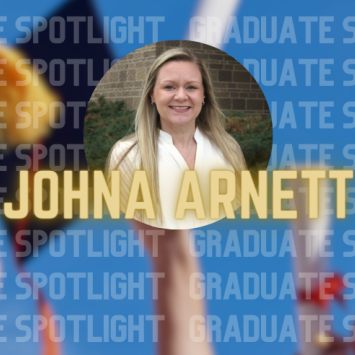
|
Graduate Spotlight: Johna Arnett, DNPGraduate Spotlight: Johna Arnett, DNP
Congratulations to Johna Arnett, DNP, RN, on her graduation from the University of Kentucky (UK) College of Nursing (CON) with her Doctor of Nursing Practice (DNP). Dr. Arnett’s project, “The Impact a Nurse Recruiter has on Nursing Staff Shortages and Nurse Manager Satisfaction in an Acute Psychiatric Facility” explores the impact of a nurse recruiter role in addressing nursing staff shortages and nurse manager satisfaction within an acute psychiatric facility. Dr. Arnett is a Nurse Manager at Eastern State Hospital (ESH). Having begun her career as a clinical nurse at Eastern State Hospital in 2015, Dr. Arnett has remained dedicated in her pursuit of professional growth and development within the same institution. Along Dr. Arnett’s journey, she transitioned from a clinical role to into a patient care manager role. Dr. Arnett’s decision to pursue a DNP was driven by her passion for executive leadership and a desire to ignite positive change within the healthcare landscape.
Throughout her academic pursuit, Dr. Arnett has participated in and benefited from the Work Learning Program (WLP) at Eastern State Hospital (ESH), finding support in a community that showed dedication to fostering growth and collaboration. Dr. Arnett notes that this program has been extremely beneficial in shaping her academic journey, providing invaluable resources and a nurturing environment conducive to learning and professional development. In fact, Dr. Arnett completed her BSN through the WLP program prior to entering the DNP WLP. In reflecting on her journey, Dr. Arnett emphasizes the importance of a strong support system and the invaluable role played by EHS and the WLP in her success. Marc Woods, Chief Nursing Officer for UK Healthcare, comments, “Dr. Johna Arnett's journey from clinical nurse to a transformative leader shows the impact of dedication on shaping the future of nursing. Her focus on education and empowerment sets a strong example for the next generation of nurse leaders." Dr. Arnett's accomplishments have extended beyond academia to her contributions to patient care and staff development. She has mastered compassionate care practices, emphasizing how important it is to be understanding while addressing patients’ needs. Dr. Arnett emphasizes her leadership style of prioritizing staff education and empowerment. She also hopes to inspire her team toward excellence and to approach challenges with humility and compassion. Now that Dr. Arnett has successfully completed the DNP program, she is excited about the opportunities that lie ahead. She will begin the Leadership Grow Program at UK in Fall 2024 to further enhance her leadership skills.
Congratulations, Dr. Arnett! Dimensions of Wellbeing
|
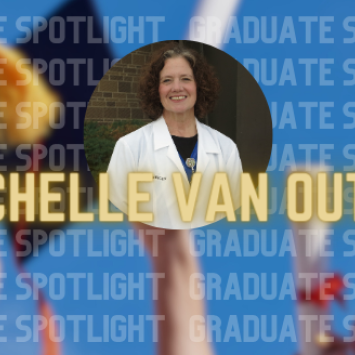
|
Graduate Spotlight: Michelle Van Outer, DNPGraduate Spotlight: Michelle Van Outer, DNP
Congratulations to Michele Van Outer, DNP, BSN, on her graduation from the University of Kentucky (UK) College of Nursing (CON) with her Doctor of Nursing Practice (DNP). Dr. Van Outer’s project, “Improving Structural Empowerment Through the Co-Creation of a Professional Governance Program of Nurse Managers and Frontline Nurse Leaders” aims to uncover the potential benefits of a collaborative approach on staff members’ patient care outcomes. Dr. Van Outer serves as a Nurse Manager at Eastern State Hospital (ESH). Dr. Van Outer began her career as an associate degree Nurse (ADN) at ESH developing her skill in patient care. Over time, she completed her BSN and is graduating May 2024 with her DNP in the Executive Leadership track. From her time as a floor nurse to her DNP, Van Outer has consistently found herself in leadership roles where she can impact best practices for patient care.
Dr. Van Outer has always been passionate about community support and public health relations and how they impact patient care. During her early nursing education, she was already interested in mental health and psychiatric nursing. She understands how inpatient psychiatric hospitals provide crucial support for underserved communities, often serving as a last resort for seeking care. Dr. Van Outer states, “We provide evidence-based care at ESH for people who, maybe, wouldn't be able to access it any other way.” Throughout her academic journey, Dr. Van Outer mentioned how beneficial the support was from her cohort and the Work Learning Program (WLP) at ESH. She specifically appreciated Dr. Okoli’s writing workshops and the support from WLP leaders in reviewing papers and conceptualizing assignments. She notes, “It was a four-year program; so, with that extra support, it enabled us to keep going because when you got in a bind, we had each other, but we also had the Work Learning Program (WLP) and their experience and research.”
Dr. Marc Woods, Chief Nursing Officer with UK Health Care notes, "Dr. Michelle Van Outer's resilient pursuit of her doctoral degree showcases her unwavering dedication to leadership in nursing. Her work on shared governance not only enhances her capabilities but also inspires others in the healthcare field to excel in this area."
Now that Dr. Van Outer has successfully completed the DNP program, she has time to appreciate her new accomplishment. Her goal remains to eventually transition into a director position and to continue to support nurse leaders.
Congratulations, Dr. Van Outer! Dimensions of Wellbeing
|
